Once upon a time, escaping an aircraft was a tricky business. You had to unstrap yourself, fling open a heavy glass canopy, and try to wrench yourself out of a small opening without getting smacked by the tail or chopped up by the propeller. Many pilots failed this difficult task, to the tragic loss of their lives.
Eventually, the human cost was heavy enough and militaries grew strained at having to train new pilots to replace the experienced ones lost to accidents and enemy fire. The ejection seat was developed to make escaping a plane as simple as tucking yourself in and pulling a big red handle. Let’s dive in and learn how it came to be.
EJECT! EJECT!
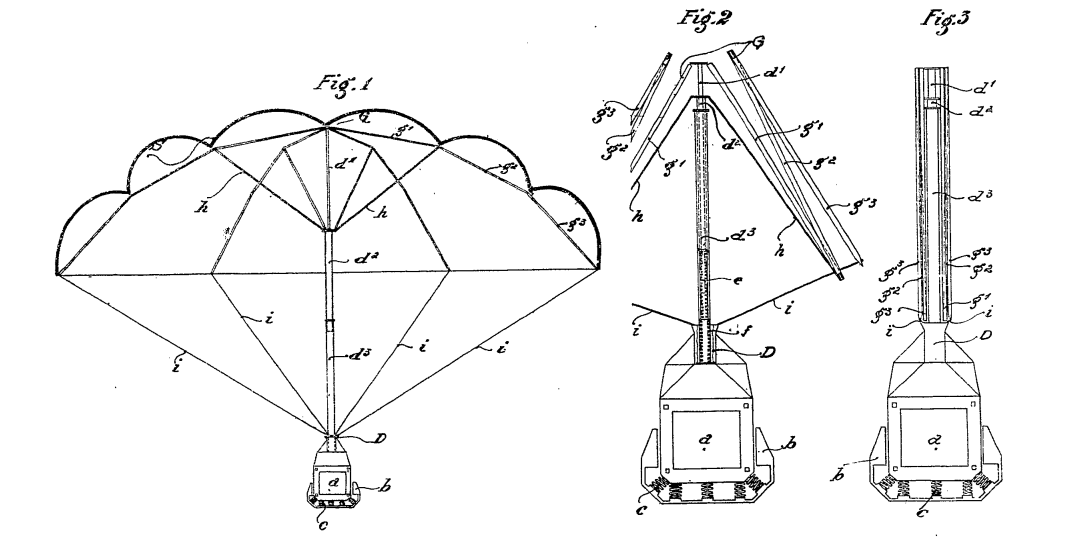
Ejector seats are a marvel of engineering that turned the tide for pilot safety in the mid-20th century. They’re just another arm of the relentless pursuit of innovation in aviation. They emerged from the necessity to provide a quick and reliable escape mechanism for expensive, highly-trained pilots. They quickly became an invaluable asset to air forces across the world, particularly with the development of ever faster military aircraft. Before ejector seats, pilots had to manually bail out of their aircraft, a risky and often fatal endeavor complicated by high speeds or low altitudes. The advent of the ejector seat was a groundbreaking development, offering a glimmer of hope in the otherwise perilous domain of aerial combat.
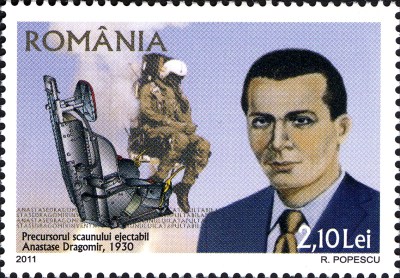
The earliest attempts at creating an ejector seat were as rudimentary as they were daring. Early ideas began to spawn shortly after the development of the aircraft; one such idea from inventor Everard Calthrop in 1916 involved using compressed air to eject a parachute that would then pull the pilot from the airplane. A concept more akin to the modern idea of an ejection seat was later pioneered by Romanian Anastase Dragomir towards the end of the 1920s. He was able to test his idea of a “catapulted cabin” in Paris in 1929, securing patents along the way for his idea.
World War II would become the real impetus for the development of the ejector seat, however. At the time, pilots and crews of military aircraft were limited to desperately clambering out of a faltering, damaged airplane, ideally quickly enough that they could pull the chute with enough altitude left to slow down before hitting the ground. Aircraft designers at Heinkel and Saab independently recognized the dire need for a safe escape mechanism, and began to develop primitive ejector seats. These early models were far from the sophisticated systems we know today, but they laid the foundation for a technology that would evolve dramatically over the ensuing decades. The concept of an ejector seat, however, was not just a product of wartime necessity. It was also a reflection of the rapid advancements in aircraft speed and altitude, which made traditional methods of escape increasingly impractical and dangerous.
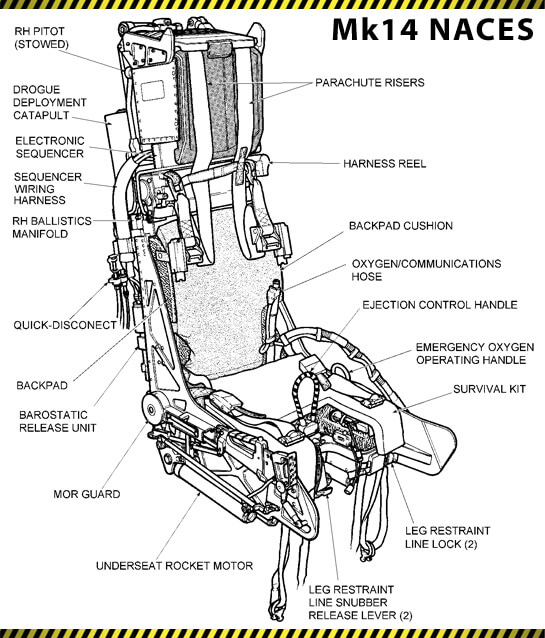
The core principle of an ejector seat is relatively straightforward: to propel the pilot out of the aircraft to a safe distance, where they can deploy a parachute and descend to the ground. The mechanism behind this life-saving device is a blend of precise engineering and controlled explosive power. At its heart lies a compressed air system, rocket, or an explosive charge, which, when activated, rapidly generates enough force to eject the seat and its occupant from the aircraft. This process must be meticulously timed and executed, as even a split-second delay can mean the difference between life and death. Indeed, it’s not just about the seat itself, either. The ejector seat is necessarily paired with other explosive devices that eject the canopy or other parts of the aircraft out of the way prior to launching the pilot to safety.
The whole process must take place with perfect timing, and it all happens in mere seconds. The canopy is blown off first, before the pilot is launched clear by the pyrotechnics. What happens next depends on the situation. If the ejection was at particularly high altitude, the seat falls for some time before deploying the full parachute to reach a safer altitude where the air is thicker. Alternatively, if the ejection was at low altitude, the parachute is opened shortly after leaving the aircaft.
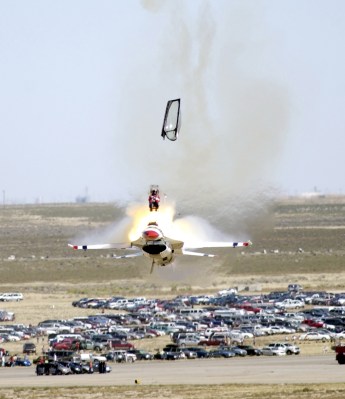
The earliest models of ejection seat that saw real use were fitted to some of the more obscure German planes used in the war. The first ejection from a damaged aircraft was by Helmut Schenk, a test pilot flying the Heinkel He 280. During a test flight in early 1942, Schenk found his controls iced up and unresponsive, and chose to abandon the aircraft using the rudimentary ejection seat powered by compressed air. Later models from Heinkel used a seat that used wheels that ran on two pipes like rails in the back of the cockpit. The seat also featured caps that sealed over the ends of those pipes. Explosive charges placed into those pipes could be fired to eject the seat, as the gases produced blew the caps off, forcing the seat upwards and carrying the pilot, ideally, to safety.
Explosive charges remained a common method of designing ejection seats, but the technology ran into a hitch as aircraft flew ever faster. Faster planes needed ejection seats that could more quickly clear the pilot from the plane. The problem was that the shock loading of a rapid explosive release of gas was hard on a pilot’s spine, and increasing this further wasn’t possible without causing excessive injury. Rocket propelled seats would eventually become the norm, providing a smoother, more continuous acceleration to the seat, and thus, the pilot. The first was fitted to the Convair F-102 Delta Dagger in 1958.
Better and Better
In its evolution, the ejector seat has seen numerous innovations. Early models were limited to a certain performance envelope in which they were effective. Pilots were educated on the minimum altitude and maximum speed limits at which their ejector seat would be effective. Eventually, seats improved, with one of the key developments being the introduction of a zero-zero capability. This means the seat can be used effectively even when the aircraft is stationary and at sea level. More modern developments have seen the integration of advanced sensors and automated systems further enhanced the reliability and safety of ejector seats. These systems are capable of detecting the aircraft’s condition and automatically initiating the ejection sequence if the pilot is incapacitated or unable to do so.
Modern ejector seats are also designed with human ergonomics in mind. They must accommodate a wide range of pilot sizes and weights, ensuring that the ejection process is as safe as possible for all occupants. This consideration extends to the forces exerted on the pilot during ejection, which can be immense. Manufacturers have continuously refined their designs to minimize the risk of injury from the ejection process itself. It bears noting that an ejection is still often a highly dangerous and intense event for a pilot. Modern Western ejection seats subject the pilot to forces on the order of 12-14 G. Earlier Soviet designs have been stated to be even more aggressive, often from 20-22 G. Injuries to the spine are common, and it’s not unheard of for pilots to suffer dislocations or broken bones in the tumult of an ejection from a stricken aircraft.

Another critical component in an ejection seat is the personal survival pack, designed to keep the pilot alive in for the immediate future. This includes a basic gear like a radio, first aid supplies, water and food rations, and usually a life raft in case the plane goes down over water. In the Western world, the most famous ejection seat manufacturer is Martin-Baker, which maintains an exclusive club of pilots who have had to rely on their products in an emergency situation. The Ejection Tie Club, as it is known, is full of members who can speak of the challenge of clambering into a life raft after having pulled the ejection handles and fallen out of the sky in dramatic fashion.
An ejection seat is, today, considered a vital life saving device in many military aircraft. At times, the technology has even become an ethical and political sore point. Britain faced a crisis in the Royal Air Force in the 1950s and 1960s when V-bomber pilots had access to ejection seats, while their support crews had to bail out by hand. Fatal accidents put a black mark on the aircraft, and air crews would share dark jokes about expecting the pilots to go down with the rest of the crew if the worst were to occur. The case of the V-Bombers highlighted just how much ejector seats had changed military aviation. Pilots had grown to expect a high-tech escape system to evacuate their aircraft in a crisis. Other crew members on larger aircraft like bombers often weren’t so lucky. It lead to the development of large escape capsules for some aircraft like the General Dynamics F-111, or provision for multiple ejection seats for crew in planes like the Rockwell B1.
In the end, the story of the ejector seat is one of continual improvement and adaptation. From its crude beginnings in World War II to the high-tech marvels found in today’s advanced fighter jets, ejector seats represent a fascinating intersection of necessity, innovation, and technology. They not only save lives but also embody the relentless human spirit to push the boundaries of what’s possible in aviation safety. As aircraft continue to evolve, so too will the ejector seats, ensuring that pilots have the best possible chance of survival in the most extreme circumstances.

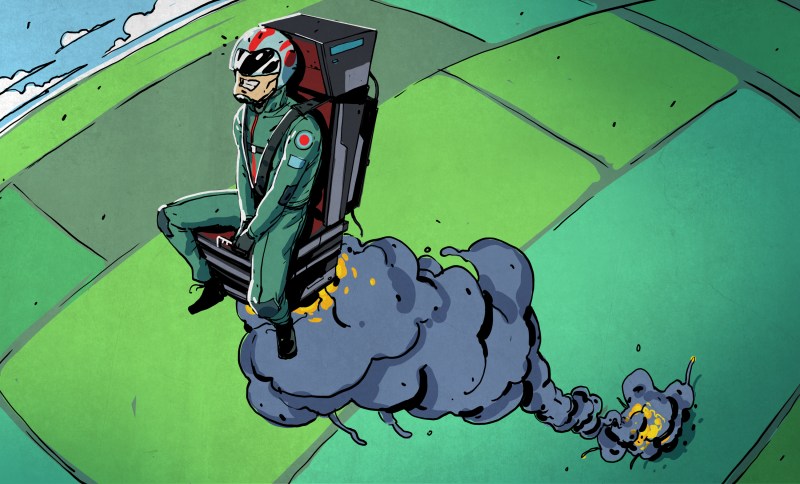















Worthwhile reading https://www.amazon.co.uk/Eject-John-Nichol/dp/139850940X/ref=asc_df_139850940X/?tag=googshopuk-21&linkCode=df0&hvadid=641694124023&hvpos=&hvnetw=g&hvrand=15259699534667874662&hvpone=&hvptwo=&hvqmt=&hvdev=m&hvdvcmdl=&hvlocint=&hvlocphy=9046247&hvtargid=pla-1782661271647&psc=1&mcid=68e54817662f3b37bec819ffdb44bdab&th=1&psc=1
Do you think you left on enough tracking code with that URL? Are you sure you don’t want to add some more?
There’s room for improvement (stupid phone just displayed a shortened url)
Fun fact #1: Chuck Yeagar could not have bailed out of the XS-1 plane that first broke the sound barrier. No ejection seat, and the door for entry was on his right, a bit in front of the wing…not a good place to crawl out unless you like being sliced into at least two pieces.. He did have a parachute but said “it was there just for me to sit on”.
Fun fact #2: The Gemini flights of the 60s did not have an escape-tower rocket to pull the craft out of danger in the event of disaster. They had ejection seats that had been engineered to escape at high speeds—big rocket in the seat. The least that the crew could have expected was some crushed vertebrae if they’d been used.
Fun fact #3 you dont eject up on helicopters without removing blades first. Some Russian design use down ejection, but those have issues too.
Seems prudent. You ever do that trick where you thrust your hand through the ceiling fan and touch the ceiling real fast without interrupting the fan? Yeah I wouldn’t wanna try that in a helicopter
I feel like if the rotor is still on and spinning that I’d rather take my chances autorotating down. But I’m no pilot, I don’t have the skills to pull of either an autorotate maneuver nor can I operate an ejection seat.
Autorotation is mostly a myth.
I’ll explain.
Certainly from an appropriate altitude it is possible and “safe” to do. problem is that helicopters are useful for flying slow, hovering, or flying at low altitude. Below a certain speed/altitude (total energy of heli+ rotorhead) there is no hope for an auto and you are not flying you are a falling mass.
Re: rotor head mass/energy. For example the R22 helicopter that is mostly (mis)used as a trainer has about 1.4, maybe 1.6 seconds between engine cut out and perfect management to avoid becoming an unrecoverable falling rock. And that from an appropriate total energy state.
For large turbine helicopters there is a better safety margin but I do t know by how much.
the *only* chopper in service with ejection seats is the Ka-52 and it does so by separating the blades and ejecting both occupants *up*
Fun fact #3: Early Starfighters used a downward-firing ejection seat (the Stanley C-1), out of concern over the ability of an upward-firing seat to clear the “T-tail” empennage. This presented obvious problems in low-altitude escapes, and 21 USAF pilots, including test pilot Captain Iven Carl Kincheloe Jr., failed to escape from their stricken aircraft in low-level emergencies because of it. The downward-firing seat was replaced by the Lockheed C-2 upward-firing seat, which was capable of clearing the tail, but still had a minimum speed limitation of 90 kn (104 mph; 167 km/h). Many export Starfighters were later retrofitted with Martin-Baker Mk.7 “zero-zero” (zero altitude and zero airspeed) ejection seats.
I read somewhere that F-104 pilots were trained in a low level emergency to attempt to roll the plane upside down before ejecting. Then the first time an F-104 fitted with an upward ejecting seat got into trouble at low altitude, the pilot forgot about the new seat and rolled before ejecting.
Pretty sure you have confused the B1, which ejects a crew capsule and the F-111 which had two ejector seats, one for each pilot.
The F-111 had a “Crew Escape Module”. Essentially the whole cockpit separated from the rest of the aircraft. It landed via parachute, and could float if it landed in water.
https://www.thedrive.com/the-war-zone/f-111-aardvarks-crew-escape-module-ejected-the-whole-cockpit
… and the joystick was used as a bilge pump if the capsule landed in water.
https://www.nationalmuseum.af.mil/Visit/Museum-Exhibits/Fact-Sheets/Display/Article/197523/f-111a-escape-module/
The first prototype B-1As had a crew capsule, but the production B-1Bs went to conventional ejection seats.
https://www.dailymail.co.uk/news/article-9639925/Two-Iranian-fighter-jet-pilots-killed-ejector-seats-activate-off.html
https://www.theguardian.com/uk-news/2018/feb/23/ejector-seat-maker-fined-11m-death-red-arrows-pilot-sean-cunningham
This F-5 looks more like a MiG-28…
The statement about zero zero capability makes me wonder where we are now in terms of operating window. Because high speed towards the ground seems to be harder, especially if you mix in the angle of the ejection for a plane that is in a steep dive. Anyone know where to find this information?
Don’t know the capabilities of the latest Martin-Baker and ACES seats, but the Russians had/have? seats that can determine the velocities and angles the seats will fly out of the aircraft and right the seat. At an airshow, a Russian pilot had to eject with the aircraft rolling almost inverted. The seat punched him out, righted itself and the pilot, and a chute morter pulled the chute out, and the pilot landed okay!
Combat flight simulators had to have their fake ejection handles movable otherwise well trained pilots would hurt their arms trying to pull on them during a simulated failure.
Train like you fight and never simulate a necessary action unless directed to do so by a facilitator.
Flying in an ejection seat aircraft is serious business. They use safety pins to ensure they don’t accidentally get pulled while climbing into and out of the aircraft. It’s always a little scary pulling the safety pin out, arming a rocket that you are sitting on. It is nice to know it’s there if you need to get out in a hurry though.
Didn’t someone say the worst thing you could do in an airplane is crash and the second worst thing was ejecting from an airplane?
If you can walk away from a landing, it’s a good landing. If you use the airplane the next day, it’s an outstanding landing.
– Chuck Yeager.
My grandfather worked for Martin-Baker just after WW2. He was responsible for design and adoption of leg restraints and canopy cutters – the protruding bits above the pilots head are designed to break the canopy if the explosive bolts fail.
He also put the seats in the Avro Arrows that flew. And spent a lot of time travelling across Canada investigating every ejection.
He had some great stories about his time with the company
An old saying is “Meet your maker in a Martin-Baker.”
We lost one aircrew member when I was at Seymour Johnson (1982) when his chute apparently didnt open and another at Clark when the plane rolled during takeoff (wing was not locked on one side and folded). Becase of the ejection sequence, he was shot out horizontally (did not survive). Ironically my wife was driving on base and witnessed it.
The A-3 Skywarrior, a naval strategic bomber, had all ejection seats deleted to save weight, as the aircraft was already operating on the edge of safe carrier performance
The A-3D was nicknamed by the pilots “All 3 Dead”.
Absolutely love the art work. Is it still Joe Kim that does these? Such good work!
More fun facts, the term “Murphy’s law” was coined by a test pilot based at Wright-Patterson AFB during the 1950s, who got voluteered for everything the base was doing. Including Ejection seat testing. CF. Lloyd Mallan wrote an excellent book on all that. Also one on space suits all to the time the book came out.
you eject when you are more afraid of the plane than the seat
Obligatory:
https://youtu.be/E5Hrvza9FkM?feature=shared
That F-16 was a Thunderbirds plane that crashed at Mountain Home AFB in Idaho. I was there, saw it crash. The pilot failed to adjust the altitude to begin his first maneuver for the local altitude and was too low as he pulled out of the dive. He was supposed to make a low pass down the runway but managed to aim the plane towards empty ground before ejecting.
The Thunderbirds changed some procedures after that, but not to what I figured would be the logical thing to do. That would be zeroing their altimeters to the local elevation so they could simply know that *this* maneuver starts at *that* altitude. But nope, they still have to use different altitude at every airfield, local elevation is X above mean sea level plus however high above that each maneuver should be performed.
Of course in the First World War, pilots weren’t even given parachutes, even though parachutes existed and were well-proven at the time. The military thought giving pilots the option to bail out would lead to “cowardice in the face of the enemy.”
War is a disgusting business in every sense of both words.